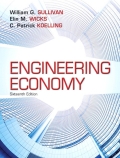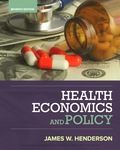
Engineering Economy
16th Edition
ISBN: 9780133582819
Author: Sullivan
Publisher: DGTL BNCOM
expand_more
expand_more
format_list_bulleted
Question
Chapter 8, Problem 18P
(a):
To determine
Calculate the total interest.
(b):
To determine
Calculate the Cost in 2009.
(c):
To determine
Calculate the estimated cost.
Expert Solution & Answer
Want to see the full answer?
Check out a sample textbook solution
Students have asked these similar questions
10.As COVID-19 came about, consumers' relationship with toilet
paper changed and they found themselves desiring more than
usual. Eventually, toilet paper producers saw an opportunity to
make more money and meet the growing demand. Which best
describes this scenario as depicted in Snell's 2020 article?
A. The demand curve shifted left and the supply curve shifted left
B. The demand curve shifted left and the supply curve shifted right
C. The demand curve shifted right and the supply curve shifted left
D. The demand curve shifted right and the supply curve shifted right
5. Supply and Demand. The graph below shows supply and demand curves for
annual medical office visits. Using this graph, answer the questions below.
P↑
$180
$150
$120
$90
$60
$30
4
8
12 16 20 24 28 32 36
a. If the market were free from government regulation, what would be the
equilibrium price and quantity?
b. Calculate total expenditures on office visits with this equilibrium price and quantity.
c. If the government subsidized office visits and required that all consumers were to
pay $30 per visit no matter what the actual cost, how many visits would consumers
demand?
d. What payment per visit would doctors require in order to supply that quantity of
visits?
e. Calculate total expenditures on office visits under the condition of this $30 co-
payment.
f. How do total expenditures with a co-payment of $30 compare to total expenditures
without government involvement? Provide a numerical answer. Show your work.
4. The table below shows the labor requirements for Mr. and Mrs.
Howell for pineapples and coconuts. Which is the most accurate
statement?
A. Mrs. Howell has a comparative advantage in coconuts and the
opportunity cost of 1 coconut for Mrs. Howell is 4 pineapples
B. Mrs. Howell has a comparative advantage in pineapples and the
opportunity cost of 1 pineapple for Mrs. Howell is .25 coconuts.
C. Mr. Howell has a comparative advantage in pineapples and the
opportunity cost of 1 pineapple is 1 coconut.
D. Mr. Howell has a comparative advantage in both pineapples and
coconuts and should specialize in pineapples.
Labor Requirements for Pineapples and Coconuts
1 Pineapple
1 Coconut
Mr. Howell
1 hour
1 hour
Mrs. Howell
1/2 hour
2 hours
Chapter 8 Solutions
Engineering Economy
Ch. 8 - Prob. 1PCh. 8 - Prob. 2PCh. 8 - Prob. 3PCh. 8 - Prob. 4PCh. 8 - Prob. 5PCh. 8 - Prob. 6PCh. 8 - Prob. 7PCh. 8 - Prob. 8PCh. 8 - Prob. 9PCh. 8 - Prob. 10P
Ch. 8 - Prob. 11PCh. 8 - Prob. 12PCh. 8 - Prob. 13PCh. 8 - A commercial building design cost 89/square-foot...Ch. 8 - Prob. 15PCh. 8 - Prob. 16PCh. 8 - Prob. 17PCh. 8 - Prob. 18PCh. 8 - Prob. 19PCh. 8 - Prob. 20PCh. 8 - Prob. 21PCh. 8 - Prob. 22PCh. 8 - Prob. 23PCh. 8 - Prob. 24PCh. 8 - Prob. 25PCh. 8 - Prob. 26PCh. 8 - Prob. 27PCh. 8 - Prob. 28PCh. 8 - Prob. 29PCh. 8 - Prob. 30PCh. 8 - Prob. 31PCh. 8 - Prob. 32PCh. 8 - Prob. 33PCh. 8 - Prob. 34PCh. 8 - Prob. 35PCh. 8 - Prob. 36PCh. 8 - Prob. 37PCh. 8 - Prob. 38PCh. 8 - Prob. 39PCh. 8 - Prob. 40PCh. 8 - Prob. 41PCh. 8 - Prob. 42PCh. 8 - Prob. 43PCh. 8 - Prob. 44PCh. 8 - Prob. 45PCh. 8 - Prob. 46PCh. 8 - Prob. 47PCh. 8 - Prob. 48PCh. 8 - Prob. 49SECh. 8 - Prob. 50SECh. 8 - Prob. 51SECh. 8 - Prob. 52CSCh. 8 - Suppose the cost of electricity is expected to...Ch. 8 - Prob. 54CSCh. 8 - Prob. 55FECh. 8 - Prob. 56FECh. 8 - Prob. 57FECh. 8 - Prob. 58FECh. 8 - Prob. 59FECh. 8 - Prob. 60FECh. 8 - Prob. 61FE
Knowledge Booster
Similar questions
- 4. Supply and Demand. The table gives hypothetical data for the quantity of electric scooters demanded and supplied per month. Price per Electric Scooter Quantity Quantity Demanded Supplied $150 500 250 $175 475 350 $200 450 450 $225 425 550 $250 400 650 $275 375 750 a. Graph the demand and supply curves. Note if you prefer to hand draw separately, you may and insert the picture separately. Price per Scooter 300 275 250 225 200 175 150 250 400 375425475 350 450 550 650 750 500 850 Quantity b. Find the equilibrium price and quantity using the graph above. c. Illustrate on your graph how an increase in the wage rate paid to scooter assemblers would affect the market for electric scooters. Label any new lines in the same graph above to distinguish changes. d. What would happen if there was an increase in the wage rate paid to scooter assemblers at the same time that tastes for electric scooters increased? 1ངarrow_forward3. Production Costs Clean 'n' Shine is a competitor to Spotless Car Wash. Like Spotless, it must pay $150 per day for each automated line it uses. But Clean 'n' Shine has been able to tap into a lower-cost pool of labor, paying its workers only $100 per day. Clean 'n' Shine's production technology is given in the following table. To determine its short-run cost structure, fill in the blanks in the table. Fill in the columns below. Outpu Capita Labor TFC TVC TC MC AFC AVC ATC 1 0 30 1 1 70 1 2 120 1 3 160 1 4 190 1 5 210 1 6 a. Over what range of output does Clean 'n' Shine experience increasing marginal returns to labor? Over what range does it experience diminishing marginal returns to labor? (*answer both questions) b. As output increases, do average fixed costs behave as described in the text? Explain. C. As output increases, do marginal cost, average variable cost, and average total cost behave as described in the text? Explain. d. Looking at the numbers in the table, but without…arrow_forward2. Elasticity and the Minimum Wage - The following graph depicts two labor markets for cashiers. We assume the same supply curve (cashiers respond similarly to wage offers in each city) but different demand functions (employer demand is more elastic – more responsive to wages - in one city than the other, perhaps because one has higher quality retail stores than the other). The y-axis shows hourly wages in dollars; the x-axis shows the number of employees in hundreds. Wage 12 11 29 10 9 00 8 7 Supply 5 4 3 2 1 D2 12 D1 0 0 1 2 3 4 5 6 7 8 9 10 11 12 Employment 11 With minimum wage of 8 dollars: A. What is the equilibrium level of employment before the minimum wage is imposed? B. A) According to the graph and given a minimum wage of 8 dollars, how many workers would employers want to hire if the demand for workers in City #1 looked like D1? B) How does that number compare to the market equilibrium employment? C. A) In City #1 (with demand curve D1), would there be an excess supply of…arrow_forward
- The demand function for organic apples is given by Qd = 20 – 2P while the supply function is given by Qs = 4P – 10.a. Solve for the equilibrium P* and Q*.b. Carefully graph the D & S curves. Include all intercepts and P* and Q* (**enlarge your graph so you can better show the questions below use graphing paper**)i. Suppose that the government legislates a $1/gallon to be collected from the buyer. Identify the new equation for the demand curve. Plot the new demand curve (on the same graph as b).ii. Solve for the new equilibrium PT* and QT* and indicate on your graph. On the same graph, indicate the P that consumers pay (PC) and the P that producers get to keep (PS).c. On another graph with the original D and S curves, impose the same tax ($1/gallon) to sellers. Identify the new equation for the supply curve. Plot the new supply curve. i. Solve for the new equilibrium PT* and QT* and indicate on your graph. On thesame graph, indicate the P that consumers pay (PC) and the P that…arrow_forwardDon't use ai to answer I will report you answerarrow_forwardExplain and evaluate the impact of legislation on the U.S. criminal justice system, specifically on the prison population and its impact on poverty and the U.S. economy. Include significant elements and limitations such as the War on Drugs and the First Step Act.arrow_forward
- Given the following petroleum tax details, calculate the marginal tax rate and explain its significance: Total Revenue: $500 million Cost of Operations: $200 million Tax Rate: 40% Additional Royalty: 5% Profit-Based Tax: 10%arrow_forwardUse a game tree to illustrate why an aircraft manufacturer may price below the current marginal cost in the short run if it has a steep learning curve. (Hint: Show that learning by doing lowers its cost in the second period.) Part 2 Assume for simplicity the game tree is illustrated in the figure to the right. Pricing below marginal cost reduces profits but gives the incumbent a cost advantage over potential rivals. What is the subgame perfect Nash equilibrium?arrow_forwardAnswerarrow_forward
- M” method Given the following model, solve by the method of “M”. (see image)arrow_forwardAs indicated in the attached image, U.S. earnings for high- and low-skill workers as measured by educational attainment began diverging in the 1980s. The remaining questions in this problem set use the model for the labor market developed in class to walk through potential explanations for this trend. 1. Assume that there are just two types of workers, low- and high-skill. As a result, there are two labor markets: supply and demand for low-skill workers and supply and demand for high-skill workers. Using two carefully drawn labor-market figures, show that an increase in the demand for high skill workers can explain an increase in the relative wage of high-skill workers. 2. Using the same assumptions as in the previous question, use two carefully drawn labor-market figures to show that an increase in the supply of low-skill workers can explain an increase in the relative wage of high-skill workers.arrow_forwardPublished in 1980, the book Free to Choose discusses how economists Milton Friedman and Rose Friedman proposed a one-sided view of the benefits of a voucher system. However, there are other economists who disagree about the potential effects of a voucher system.arrow_forward
arrow_back_ios
SEE MORE QUESTIONS
arrow_forward_ios
Recommended textbooks for you
 Exploring EconomicsEconomicsISBN:9781544336329Author:Robert L. SextonPublisher:SAGE Publications, Inc
Exploring EconomicsEconomicsISBN:9781544336329Author:Robert L. SextonPublisher:SAGE Publications, Inc Managerial Economics: Applications, Strategies an...EconomicsISBN:9781305506381Author:James R. McGuigan, R. Charles Moyer, Frederick H.deB. HarrisPublisher:Cengage Learning
Managerial Economics: Applications, Strategies an...EconomicsISBN:9781305506381Author:James R. McGuigan, R. Charles Moyer, Frederick H.deB. HarrisPublisher:Cengage Learning
 Economics Today and Tomorrow, Student EditionEconomicsISBN:9780078747663Author:McGraw-HillPublisher:Glencoe/McGraw-Hill School Pub Co
Economics Today and Tomorrow, Student EditionEconomicsISBN:9780078747663Author:McGraw-HillPublisher:Glencoe/McGraw-Hill School Pub Co Managerial Economics: A Problem Solving ApproachEconomicsISBN:9781337106665Author:Luke M. Froeb, Brian T. McCann, Michael R. Ward, Mike ShorPublisher:Cengage Learning
Managerial Economics: A Problem Solving ApproachEconomicsISBN:9781337106665Author:Luke M. Froeb, Brian T. McCann, Michael R. Ward, Mike ShorPublisher:Cengage Learning

Exploring Economics
Economics
ISBN:9781544336329
Author:Robert L. Sexton
Publisher:SAGE Publications, Inc

Managerial Economics: Applications, Strategies an...
Economics
ISBN:9781305506381
Author:James R. McGuigan, R. Charles Moyer, Frederick H.deB. Harris
Publisher:Cengage Learning


Economics Today and Tomorrow, Student Edition
Economics
ISBN:9780078747663
Author:McGraw-Hill
Publisher:Glencoe/McGraw-Hill School Pub Co

Managerial Economics: A Problem Solving Approach
Economics
ISBN:9781337106665
Author:Luke M. Froeb, Brian T. McCann, Michael R. Ward, Mike Shor
Publisher:Cengage Learning
